Cloud Computing Cyber-Security: An Overview of the Current State
VerifiedAdded on 2022/09/18
|13
|5219
|19
Report
AI Summary
This report provides a comprehensive overview of the state-of-the-art in cloud computing cyber-security. It begins with an introduction to cloud computing, defining its characteristics and service models, including IaaS, PaaS, and SaaS, along with deployment models such as private, public, and hybrid clouds. The report then delves into the core cyber-security challenges, including data security, network infrastructure security, and the various threats associated with them, such as DDoS attacks. The report highlights the importance of data integrity, confidentiality, and availability. It also explores the current approaches, algorithms, and techniques used to address these challenges, and identifies open problems that define future research directions. The report emphasizes that despite the maturity of cloud computing security, there are numerous research areas that promise continued improvements in cloud security and privacy.
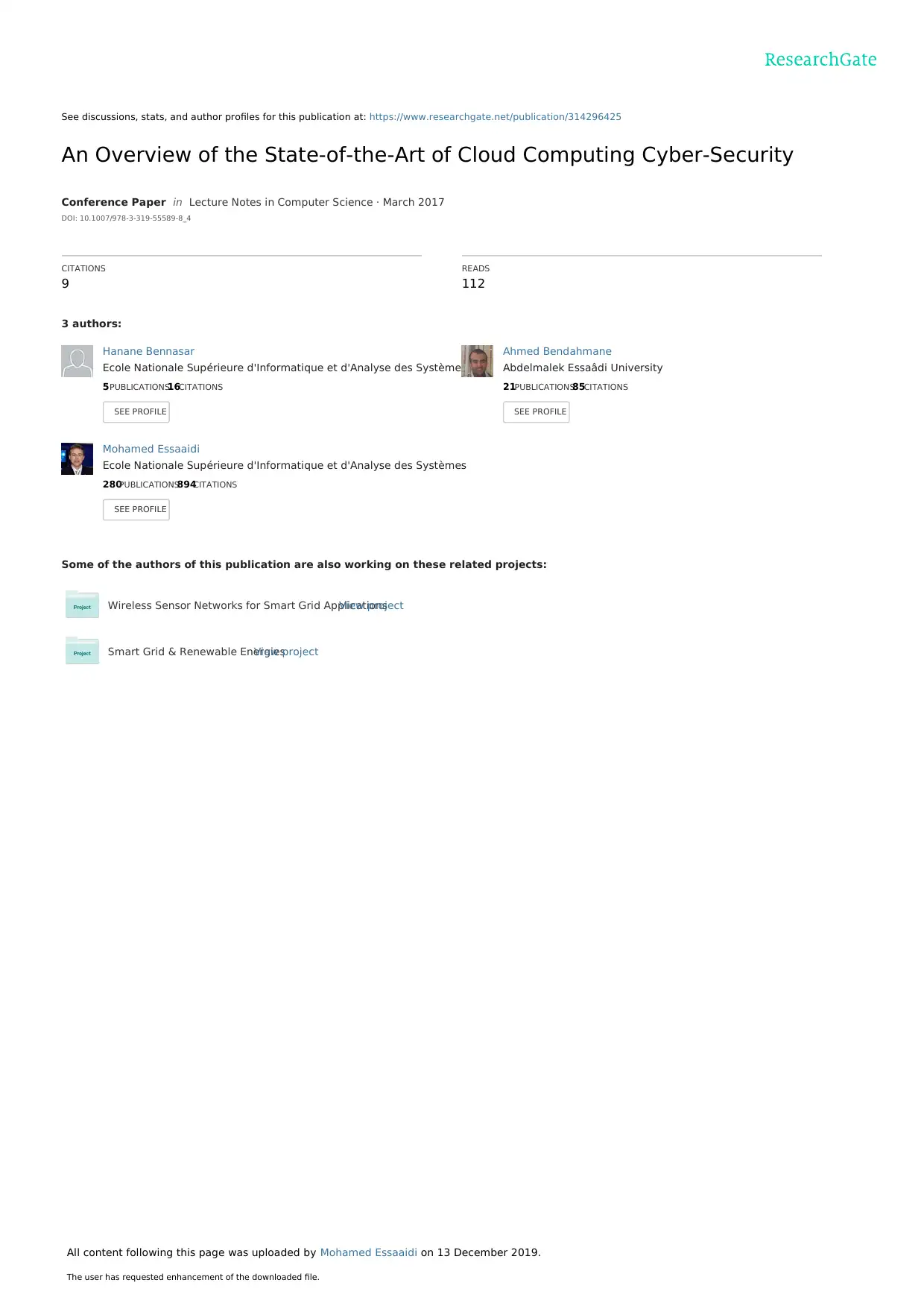
See discussions, stats, and author profiles for this publication at: https://www.researchgate.net/publication/314296425
An Overview of the State-of-the-Art of Cloud Computing Cyber-Security
Conference Paper in Lecture Notes in Computer Science · March 2017
DOI: 10.1007/978-3-319-55589-8_4
CITATIONS
9
READS
112
3 authors:
Some of the authors of this publication are also working on these related projects:
Wireless Sensor Networks for Smart Grid ApplicationsView project
Smart Grid & Renewable EnergiesView project
Hanane Bennasar
Ecole Nationale Supérieure d'Informatique et d'Analyse des Systèmes
5 PUBLICATIONS16CITATIONS
SEE PROFILE
Ahmed Bendahmane
Abdelmalek Essaâdi University
21PUBLICATIONS85CITATIONS
SEE PROFILE
Mohamed Essaaidi
Ecole Nationale Supérieure d'Informatique et d'Analyse des Systèmes
280PUBLICATIONS894CITATIONS
SEE PROFILE
All content following this page was uploaded by Mohamed Essaaidi on 13 December 2019.
The user has requested enhancement of the downloaded file.
An Overview of the State-of-the-Art of Cloud Computing Cyber-Security
Conference Paper in Lecture Notes in Computer Science · March 2017
DOI: 10.1007/978-3-319-55589-8_4
CITATIONS
9
READS
112
3 authors:
Some of the authors of this publication are also working on these related projects:
Wireless Sensor Networks for Smart Grid ApplicationsView project
Smart Grid & Renewable EnergiesView project
Hanane Bennasar
Ecole Nationale Supérieure d'Informatique et d'Analyse des Systèmes
5 PUBLICATIONS16CITATIONS
SEE PROFILE
Ahmed Bendahmane
Abdelmalek Essaâdi University
21PUBLICATIONS85CITATIONS
SEE PROFILE
Mohamed Essaaidi
Ecole Nationale Supérieure d'Informatique et d'Analyse des Systèmes
280PUBLICATIONS894CITATIONS
SEE PROFILE
All content following this page was uploaded by Mohamed Essaaidi on 13 December 2019.
The user has requested enhancement of the downloaded file.
Paraphrase This Document
Need a fresh take? Get an instant paraphrase of this document with our AI Paraphraser
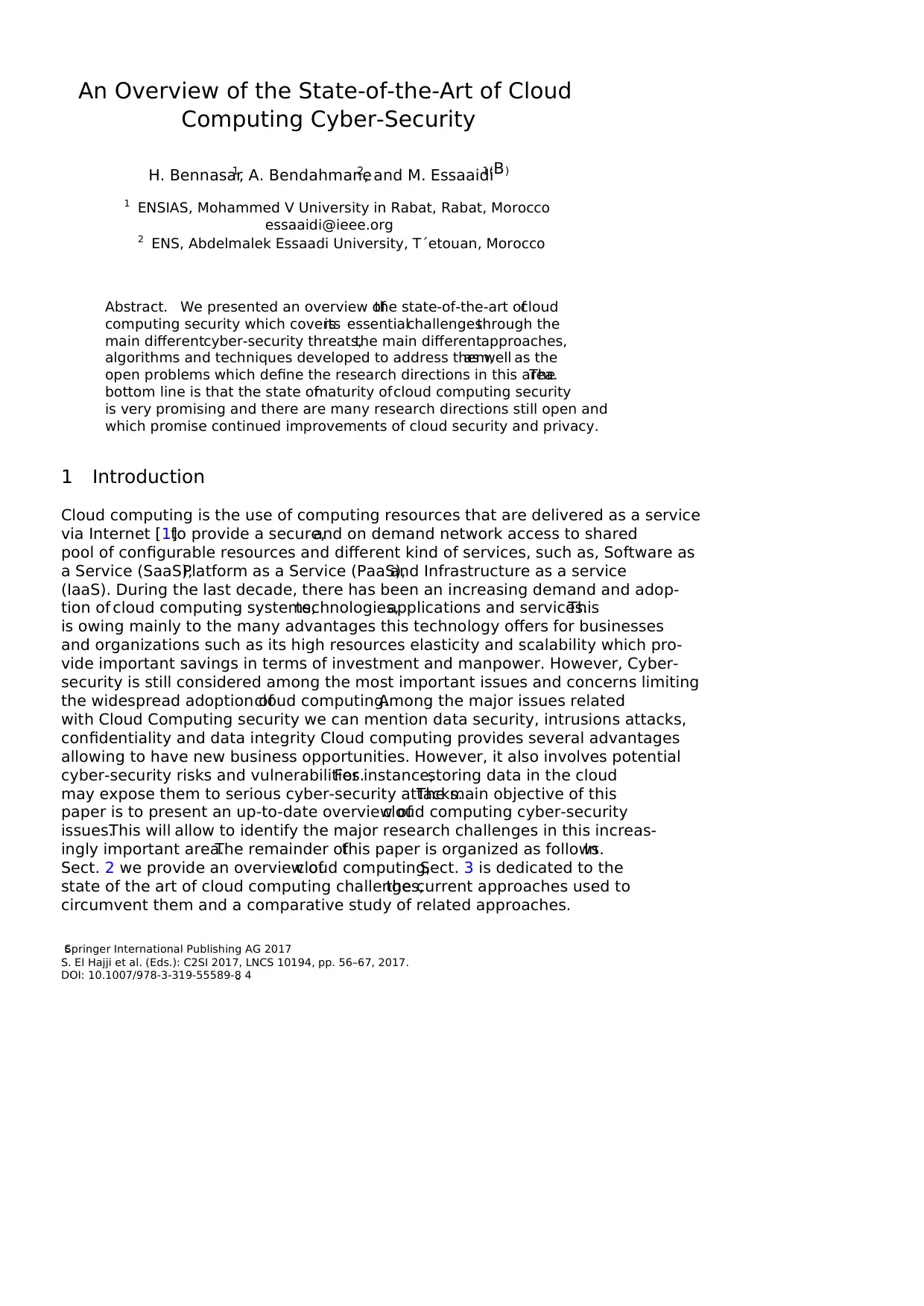
An Overview of the State-of-the-Art of Cloud
Computing Cyber-Security
H. Bennasar1, A. Bendahmane2, and M. Essaaidi1(B)
1 ENSIAS, Mohammed V University in Rabat, Rabat, Morocco
essaaidi@ieee.org
2 ENS, Abdelmalek Essaadi University, T´etouan, Morocco
Abstract. We presented an overview ofthe state-of-the-art ofcloud
computing security which coversits essentialchallengesthrough the
main differentcyber-security threats,the main differentapproaches,
algorithms and techniques developed to address them,as well as the
open problems which define the research directions in this area.The
bottom line is that the state ofmaturity ofcloud computing security
is very promising and there are many research directions still open and
which promise continued improvements of cloud security and privacy.
1 Introduction
Cloud computing is the use of computing resources that are delivered as a service
via Internet [1]to provide a secure,and on demand network access to shared
pool of configurable resources and different kind of services, such as, Software as
a Service (SaaS),Platform as a Service (PaaS),and Infrastructure as a service
(IaaS). During the last decade, there has been an increasing demand and adop-
tion of cloud computing systems,technologies,applications and services.This
is owing mainly to the many advantages this technology offers for businesses
and organizations such as its high resources elasticity and scalability which pro-
vide important savings in terms of investment and manpower. However, Cyber-
security is still considered among the most important issues and concerns limiting
the widespread adoption ofcloud computing.Among the major issues related
with Cloud Computing security we can mention data security, intrusions attacks,
confidentiality and data integrity Cloud computing provides several advantages
allowing to have new business opportunities. However, it also involves potential
cyber-security risks and vulnerabilities.For instance,storing data in the cloud
may expose them to serious cyber-security attacks.The main objective of this
paper is to present an up-to-date overview ofcloud computing cyber-security
issues.This will allow to identify the major research challenges in this increas-
ingly important area.The remainder ofthis paper is organized as follows.In
Sect. 2 we provide an overview ofcloud computing,Sect. 3 is dedicated to the
state of the art of cloud computing challenges,the current approaches used to
circumvent them and a comparative study of related approaches.
cSpringer International Publishing AG 2017
S. El Hajji et al. (Eds.): C2SI 2017, LNCS 10194, pp. 56–67, 2017.
DOI: 10.1007/978-3-319-55589-8 4
Computing Cyber-Security
H. Bennasar1, A. Bendahmane2, and M. Essaaidi1(B)
1 ENSIAS, Mohammed V University in Rabat, Rabat, Morocco
essaaidi@ieee.org
2 ENS, Abdelmalek Essaadi University, T´etouan, Morocco
Abstract. We presented an overview ofthe state-of-the-art ofcloud
computing security which coversits essentialchallengesthrough the
main differentcyber-security threats,the main differentapproaches,
algorithms and techniques developed to address them,as well as the
open problems which define the research directions in this area.The
bottom line is that the state ofmaturity ofcloud computing security
is very promising and there are many research directions still open and
which promise continued improvements of cloud security and privacy.
1 Introduction
Cloud computing is the use of computing resources that are delivered as a service
via Internet [1]to provide a secure,and on demand network access to shared
pool of configurable resources and different kind of services, such as, Software as
a Service (SaaS),Platform as a Service (PaaS),and Infrastructure as a service
(IaaS). During the last decade, there has been an increasing demand and adop-
tion of cloud computing systems,technologies,applications and services.This
is owing mainly to the many advantages this technology offers for businesses
and organizations such as its high resources elasticity and scalability which pro-
vide important savings in terms of investment and manpower. However, Cyber-
security is still considered among the most important issues and concerns limiting
the widespread adoption ofcloud computing.Among the major issues related
with Cloud Computing security we can mention data security, intrusions attacks,
confidentiality and data integrity Cloud computing provides several advantages
allowing to have new business opportunities. However, it also involves potential
cyber-security risks and vulnerabilities.For instance,storing data in the cloud
may expose them to serious cyber-security attacks.The main objective of this
paper is to present an up-to-date overview ofcloud computing cyber-security
issues.This will allow to identify the major research challenges in this increas-
ingly important area.The remainder ofthis paper is organized as follows.In
Sect. 2 we provide an overview ofcloud computing,Sect. 3 is dedicated to the
state of the art of cloud computing challenges,the current approaches used to
circumvent them and a comparative study of related approaches.
cSpringer International Publishing AG 2017
S. El Hajji et al. (Eds.): C2SI 2017, LNCS 10194, pp. 56–67, 2017.
DOI: 10.1007/978-3-319-55589-8 4
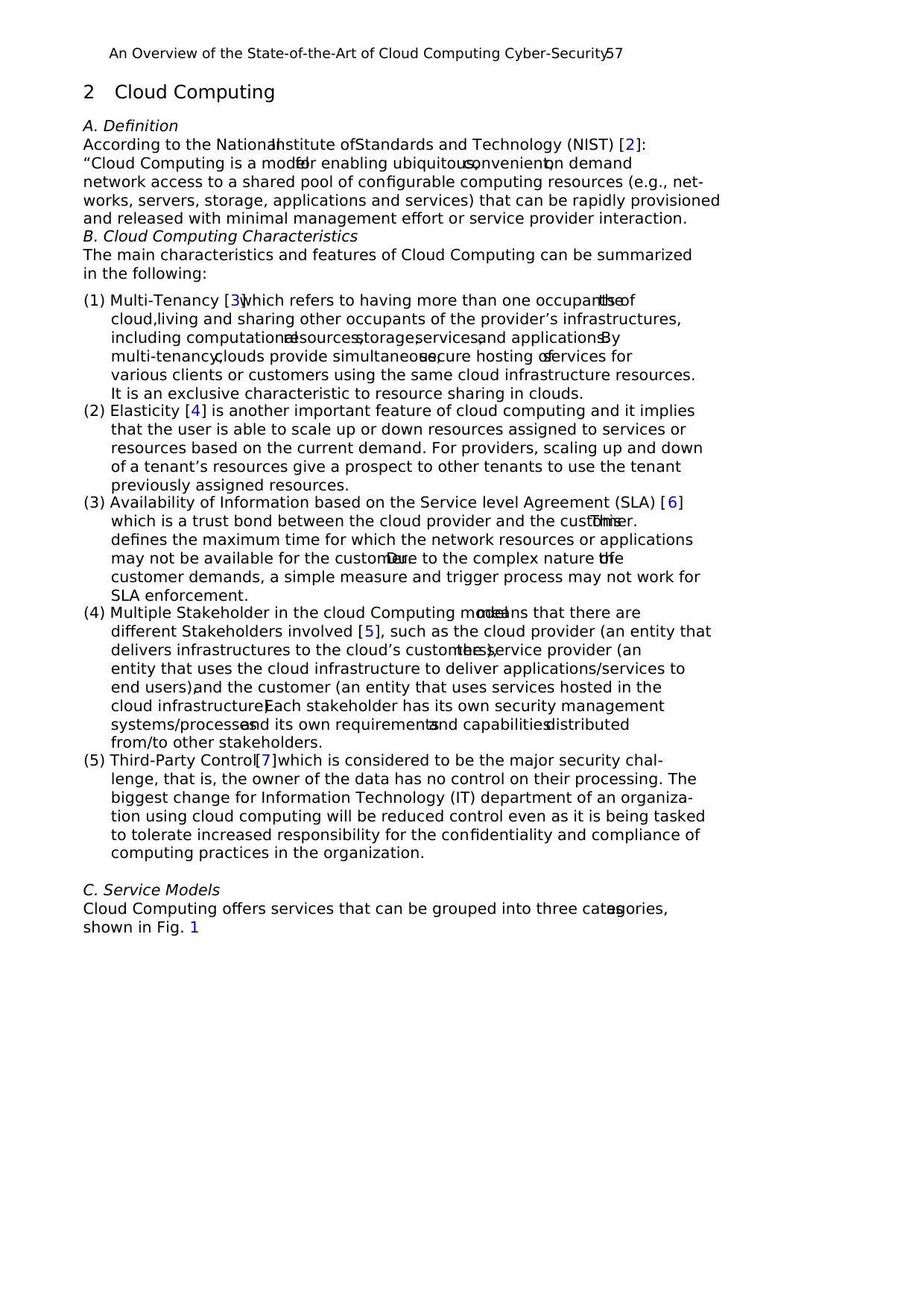
An Overview of the State-of-the-Art of Cloud Computing Cyber-Security57
2 Cloud Computing
A. Definition
According to the NationalInstitute ofStandards and Technology (NIST) [2]:
“Cloud Computing is a modelfor enabling ubiquitous,convenient,on demand
network access to a shared pool of configurable computing resources (e.g., net-
works, servers, storage, applications and services) that can be rapidly provisioned
and released with minimal management effort or service provider interaction.
B. Cloud Computing Characteristics
The main characteristics and features of Cloud Computing can be summarized
in the following:
(1) Multi-Tenancy [3]which refers to having more than one occupants ofthe
cloud,living and sharing other occupants of the provider’s infrastructures,
including computationalresources,storage,services,and applications.By
multi-tenancy,clouds provide simultaneous,secure hosting ofservices for
various clients or customers using the same cloud infrastructure resources.
It is an exclusive characteristic to resource sharing in clouds.
(2) Elasticity [4] is another important feature of cloud computing and it implies
that the user is able to scale up or down resources assigned to services or
resources based on the current demand. For providers, scaling up and down
of a tenant’s resources give a prospect to other tenants to use the tenant
previously assigned resources.
(3) Availability of Information based on the Service level Agreement (SLA) [6]
which is a trust bond between the cloud provider and the customer.This
defines the maximum time for which the network resources or applications
may not be available for the customer.Due to the complex nature ofthe
customer demands, a simple measure and trigger process may not work for
SLA enforcement.
(4) Multiple Stakeholder in the cloud Computing modelmeans that there are
different Stakeholders involved [5], such as the cloud provider (an entity that
delivers infrastructures to the cloud’s customers),the service provider (an
entity that uses the cloud infrastructure to deliver applications/services to
end users),and the customer (an entity that uses services hosted in the
cloud infrastructure).Each stakeholder has its own security management
systems/processesand its own requirementsand capabilitiesdistributed
from/to other stakeholders.
(5) Third-Party Control[7]which is considered to be the major security chal-
lenge, that is, the owner of the data has no control on their processing. The
biggest change for Information Technology (IT) department of an organiza-
tion using cloud computing will be reduced control even as it is being tasked
to tolerate increased responsibility for the confidentiality and compliance of
computing practices in the organization.
C. Service Models
Cloud Computing offers services that can be grouped into three categories,as
shown in Fig. 1
2 Cloud Computing
A. Definition
According to the NationalInstitute ofStandards and Technology (NIST) [2]:
“Cloud Computing is a modelfor enabling ubiquitous,convenient,on demand
network access to a shared pool of configurable computing resources (e.g., net-
works, servers, storage, applications and services) that can be rapidly provisioned
and released with minimal management effort or service provider interaction.
B. Cloud Computing Characteristics
The main characteristics and features of Cloud Computing can be summarized
in the following:
(1) Multi-Tenancy [3]which refers to having more than one occupants ofthe
cloud,living and sharing other occupants of the provider’s infrastructures,
including computationalresources,storage,services,and applications.By
multi-tenancy,clouds provide simultaneous,secure hosting ofservices for
various clients or customers using the same cloud infrastructure resources.
It is an exclusive characteristic to resource sharing in clouds.
(2) Elasticity [4] is another important feature of cloud computing and it implies
that the user is able to scale up or down resources assigned to services or
resources based on the current demand. For providers, scaling up and down
of a tenant’s resources give a prospect to other tenants to use the tenant
previously assigned resources.
(3) Availability of Information based on the Service level Agreement (SLA) [6]
which is a trust bond between the cloud provider and the customer.This
defines the maximum time for which the network resources or applications
may not be available for the customer.Due to the complex nature ofthe
customer demands, a simple measure and trigger process may not work for
SLA enforcement.
(4) Multiple Stakeholder in the cloud Computing modelmeans that there are
different Stakeholders involved [5], such as the cloud provider (an entity that
delivers infrastructures to the cloud’s customers),the service provider (an
entity that uses the cloud infrastructure to deliver applications/services to
end users),and the customer (an entity that uses services hosted in the
cloud infrastructure).Each stakeholder has its own security management
systems/processesand its own requirementsand capabilitiesdistributed
from/to other stakeholders.
(5) Third-Party Control[7]which is considered to be the major security chal-
lenge, that is, the owner of the data has no control on their processing. The
biggest change for Information Technology (IT) department of an organiza-
tion using cloud computing will be reduced control even as it is being tasked
to tolerate increased responsibility for the confidentiality and compliance of
computing practices in the organization.
C. Service Models
Cloud Computing offers services that can be grouped into three categories,as
shown in Fig. 1
⊘ This is a preview!⊘
Do you want full access?
Subscribe today to unlock all pages.

Trusted by 1+ million students worldwide
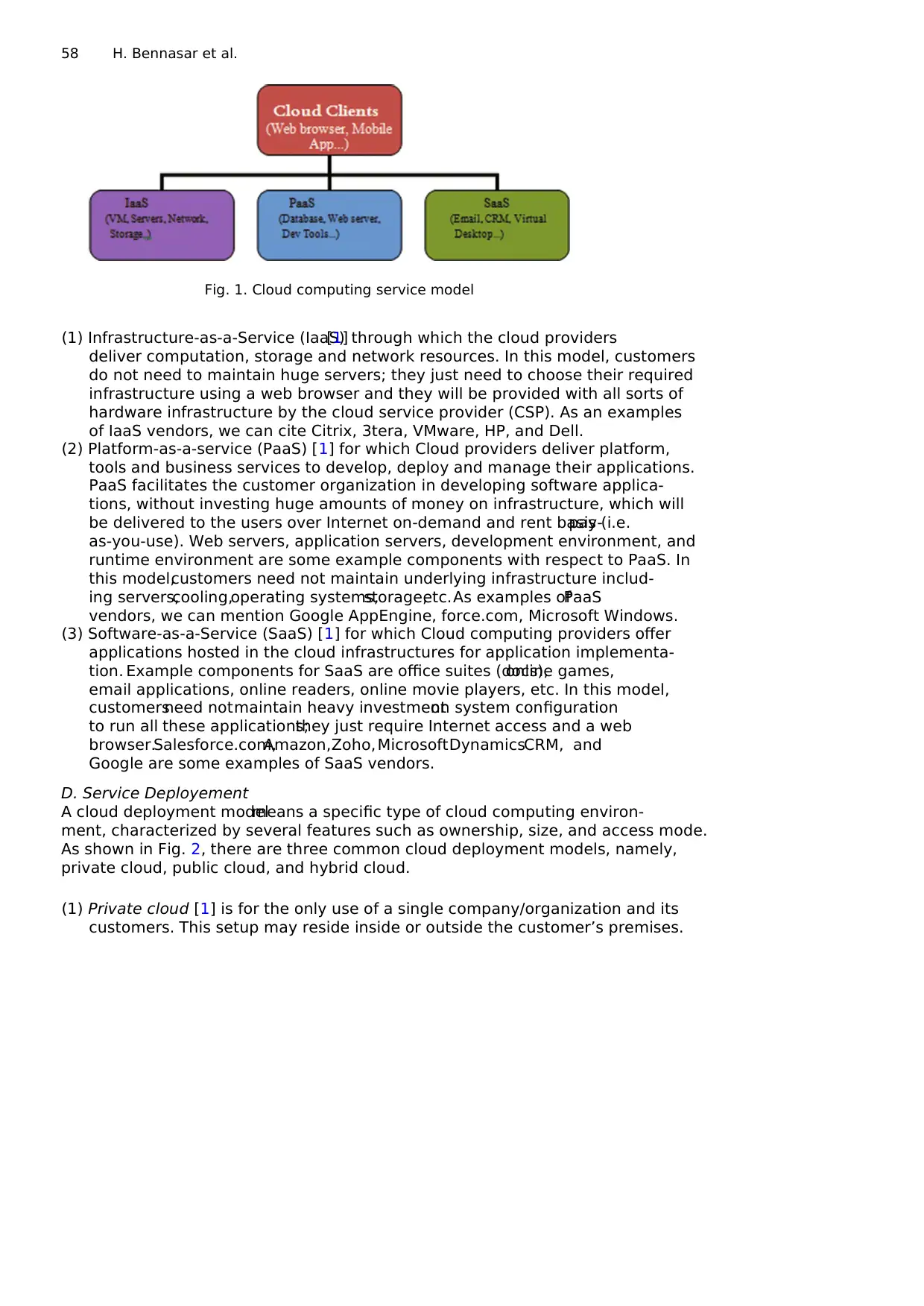
58 H. Bennasar et al.
Fig. 1. Cloud computing service model
(1) Infrastructure-as-a-Service (IaaS)[1] through which the cloud providers
deliver computation, storage and network resources. In this model, customers
do not need to maintain huge servers; they just need to choose their required
infrastructure using a web browser and they will be provided with all sorts of
hardware infrastructure by the cloud service provider (CSP). As an examples
of IaaS vendors, we can cite Citrix, 3tera, VMware, HP, and Dell.
(2) Platform-as-a-service (PaaS) [1] for which Cloud providers deliver platform,
tools and business services to develop, deploy and manage their applications.
PaaS facilitates the customer organization in developing software applica-
tions, without investing huge amounts of money on infrastructure, which will
be delivered to the users over Internet on-demand and rent basis (i.e.pay-
as-you-use). Web servers, application servers, development environment, and
runtime environment are some example components with respect to PaaS. In
this model,customers need not maintain underlying infrastructure includ-
ing servers,cooling,operating systems,storage,etc.As examples ofPaaS
vendors, we can mention Google AppEngine, force.com, Microsoft Windows.
(3) Software-as-a-Service (SaaS) [1] for which Cloud computing providers offer
applications hosted in the cloud infrastructures for application implementa-
tion. Example components for SaaS are office suites (docs),online games,
email applications, online readers, online movie players, etc. In this model,
customersneed notmaintain heavy investmenton system configuration
to run all these applications;they just require Internet access and a web
browser.Salesforce.com,Amazon,Zoho, MicrosoftDynamicsCRM, and
Google are some examples of SaaS vendors.
D. Service Deployement
A cloud deployment modelmeans a specific type of cloud computing environ-
ment, characterized by several features such as ownership, size, and access mode.
As shown in Fig. 2, there are three common cloud deployment models, namely,
private cloud, public cloud, and hybrid cloud.
(1) Private cloud [1] is for the only use of a single company/organization and its
customers. This setup may reside inside or outside the customer’s premises.
Fig. 1. Cloud computing service model
(1) Infrastructure-as-a-Service (IaaS)[1] through which the cloud providers
deliver computation, storage and network resources. In this model, customers
do not need to maintain huge servers; they just need to choose their required
infrastructure using a web browser and they will be provided with all sorts of
hardware infrastructure by the cloud service provider (CSP). As an examples
of IaaS vendors, we can cite Citrix, 3tera, VMware, HP, and Dell.
(2) Platform-as-a-service (PaaS) [1] for which Cloud providers deliver platform,
tools and business services to develop, deploy and manage their applications.
PaaS facilitates the customer organization in developing software applica-
tions, without investing huge amounts of money on infrastructure, which will
be delivered to the users over Internet on-demand and rent basis (i.e.pay-
as-you-use). Web servers, application servers, development environment, and
runtime environment are some example components with respect to PaaS. In
this model,customers need not maintain underlying infrastructure includ-
ing servers,cooling,operating systems,storage,etc.As examples ofPaaS
vendors, we can mention Google AppEngine, force.com, Microsoft Windows.
(3) Software-as-a-Service (SaaS) [1] for which Cloud computing providers offer
applications hosted in the cloud infrastructures for application implementa-
tion. Example components for SaaS are office suites (docs),online games,
email applications, online readers, online movie players, etc. In this model,
customersneed notmaintain heavy investmenton system configuration
to run all these applications;they just require Internet access and a web
browser.Salesforce.com,Amazon,Zoho, MicrosoftDynamicsCRM, and
Google are some examples of SaaS vendors.
D. Service Deployement
A cloud deployment modelmeans a specific type of cloud computing environ-
ment, characterized by several features such as ownership, size, and access mode.
As shown in Fig. 2, there are three common cloud deployment models, namely,
private cloud, public cloud, and hybrid cloud.
(1) Private cloud [1] is for the only use of a single company/organization and its
customers. This setup may reside inside or outside the customer’s premises.
Paraphrase This Document
Need a fresh take? Get an instant paraphrase of this document with our AI Paraphraser
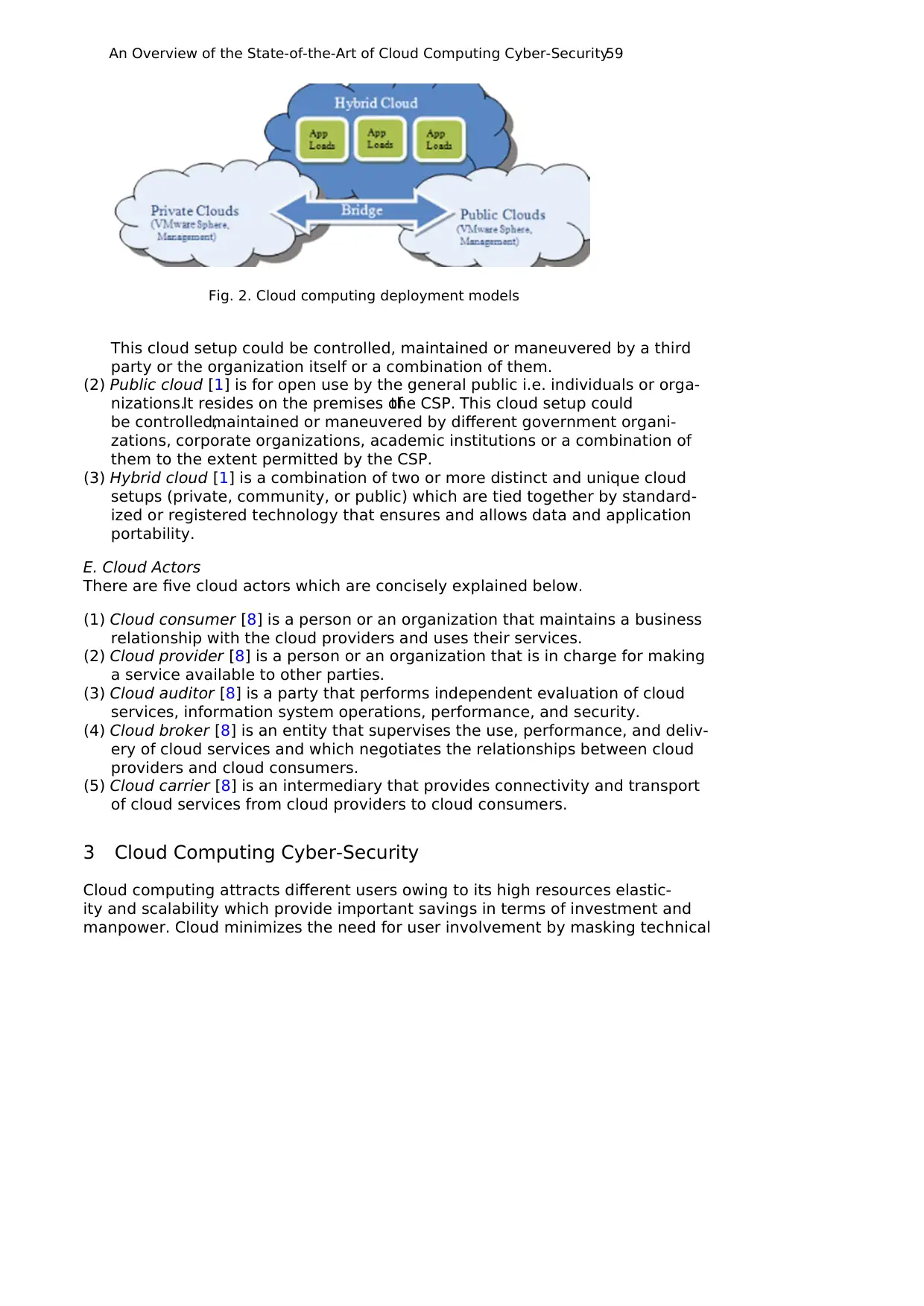
An Overview of the State-of-the-Art of Cloud Computing Cyber-Security59
Fig. 2. Cloud computing deployment models
This cloud setup could be controlled, maintained or maneuvered by a third
party or the organization itself or a combination of them.
(2) Public cloud [1] is for open use by the general public i.e. individuals or orga-
nizations.It resides on the premises ofthe CSP. This cloud setup could
be controlled,maintained or maneuvered by different government organi-
zations, corporate organizations, academic institutions or a combination of
them to the extent permitted by the CSP.
(3) Hybrid cloud [1] is a combination of two or more distinct and unique cloud
setups (private, community, or public) which are tied together by standard-
ized or registered technology that ensures and allows data and application
portability.
E. Cloud Actors
There are five cloud actors which are concisely explained below.
(1) Cloud consumer [8] is a person or an organization that maintains a business
relationship with the cloud providers and uses their services.
(2) Cloud provider [8] is a person or an organization that is in charge for making
a service available to other parties.
(3) Cloud auditor [8] is a party that performs independent evaluation of cloud
services, information system operations, performance, and security.
(4) Cloud broker [8] is an entity that supervises the use, performance, and deliv-
ery of cloud services and which negotiates the relationships between cloud
providers and cloud consumers.
(5) Cloud carrier [8] is an intermediary that provides connectivity and transport
of cloud services from cloud providers to cloud consumers.
3 Cloud Computing Cyber-Security
Cloud computing attracts different users owing to its high resources elastic-
ity and scalability which provide important savings in terms of investment and
manpower. Cloud minimizes the need for user involvement by masking technical
Fig. 2. Cloud computing deployment models
This cloud setup could be controlled, maintained or maneuvered by a third
party or the organization itself or a combination of them.
(2) Public cloud [1] is for open use by the general public i.e. individuals or orga-
nizations.It resides on the premises ofthe CSP. This cloud setup could
be controlled,maintained or maneuvered by different government organi-
zations, corporate organizations, academic institutions or a combination of
them to the extent permitted by the CSP.
(3) Hybrid cloud [1] is a combination of two or more distinct and unique cloud
setups (private, community, or public) which are tied together by standard-
ized or registered technology that ensures and allows data and application
portability.
E. Cloud Actors
There are five cloud actors which are concisely explained below.
(1) Cloud consumer [8] is a person or an organization that maintains a business
relationship with the cloud providers and uses their services.
(2) Cloud provider [8] is a person or an organization that is in charge for making
a service available to other parties.
(3) Cloud auditor [8] is a party that performs independent evaluation of cloud
services, information system operations, performance, and security.
(4) Cloud broker [8] is an entity that supervises the use, performance, and deliv-
ery of cloud services and which negotiates the relationships between cloud
providers and cloud consumers.
(5) Cloud carrier [8] is an intermediary that provides connectivity and transport
of cloud services from cloud providers to cloud consumers.
3 Cloud Computing Cyber-Security
Cloud computing attracts different users owing to its high resources elastic-
ity and scalability which provide important savings in terms of investment and
manpower. Cloud minimizes the need for user involvement by masking technical
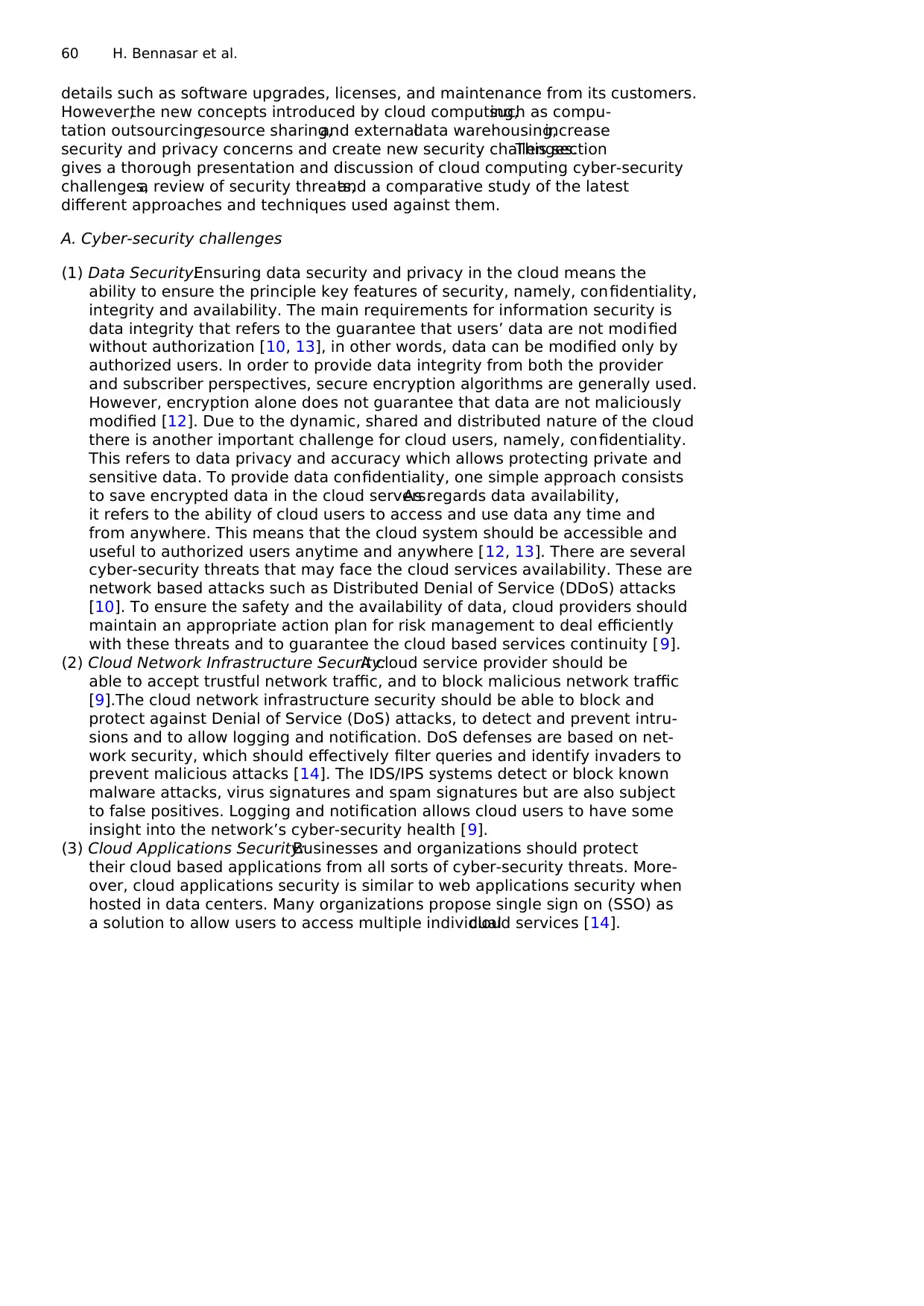
60 H. Bennasar et al.
details such as software upgrades, licenses, and maintenance from its customers.
However,the new concepts introduced by cloud computing,such as compu-
tation outsourcing,resource sharing,and externaldata warehousing,increase
security and privacy concerns and create new security challenges.This section
gives a thorough presentation and discussion of cloud computing cyber-security
challenges,a review of security threats,and a comparative study of the latest
different approaches and techniques used against them.
A. Cyber-security challenges
(1) Data Security:Ensuring data security and privacy in the cloud means the
ability to ensure the principle key features of security, namely, confidentiality,
integrity and availability. The main requirements for information security is
data integrity that refers to the guarantee that users’ data are not modified
without authorization [10, 13], in other words, data can be modified only by
authorized users. In order to provide data integrity from both the provider
and subscriber perspectives, secure encryption algorithms are generally used.
However, encryption alone does not guarantee that data are not maliciously
modified [12]. Due to the dynamic, shared and distributed nature of the cloud
there is another important challenge for cloud users, namely, confidentiality.
This refers to data privacy and accuracy which allows protecting private and
sensitive data. To provide data confidentiality, one simple approach consists
to save encrypted data in the cloud servers.As regards data availability,
it refers to the ability of cloud users to access and use data any time and
from anywhere. This means that the cloud system should be accessible and
useful to authorized users anytime and anywhere [12, 13]. There are several
cyber-security threats that may face the cloud services availability. These are
network based attacks such as Distributed Denial of Service (DDoS) attacks
[10]. To ensure the safety and the availability of data, cloud providers should
maintain an appropriate action plan for risk management to deal efficiently
with these threats and to guarantee the cloud based services continuity [9].
(2) Cloud Network Infrastructure Security:A cloud service provider should be
able to accept trustful network traffic, and to block malicious network traffic
[9].The cloud network infrastructure security should be able to block and
protect against Denial of Service (DoS) attacks, to detect and prevent intru-
sions and to allow logging and notification. DoS defenses are based on net-
work security, which should effectively filter queries and identify invaders to
prevent malicious attacks [14]. The IDS/IPS systems detect or block known
malware attacks, virus signatures and spam signatures but are also subject
to false positives. Logging and notification allows cloud users to have some
insight into the network’s cyber-security health [9].
(3) Cloud Applications Security:Businesses and organizations should protect
their cloud based applications from all sorts of cyber-security threats. More-
over, cloud applications security is similar to web applications security when
hosted in data centers. Many organizations propose single sign on (SSO) as
a solution to allow users to access multiple individualcloud services [14].
details such as software upgrades, licenses, and maintenance from its customers.
However,the new concepts introduced by cloud computing,such as compu-
tation outsourcing,resource sharing,and externaldata warehousing,increase
security and privacy concerns and create new security challenges.This section
gives a thorough presentation and discussion of cloud computing cyber-security
challenges,a review of security threats,and a comparative study of the latest
different approaches and techniques used against them.
A. Cyber-security challenges
(1) Data Security:Ensuring data security and privacy in the cloud means the
ability to ensure the principle key features of security, namely, confidentiality,
integrity and availability. The main requirements for information security is
data integrity that refers to the guarantee that users’ data are not modified
without authorization [10, 13], in other words, data can be modified only by
authorized users. In order to provide data integrity from both the provider
and subscriber perspectives, secure encryption algorithms are generally used.
However, encryption alone does not guarantee that data are not maliciously
modified [12]. Due to the dynamic, shared and distributed nature of the cloud
there is another important challenge for cloud users, namely, confidentiality.
This refers to data privacy and accuracy which allows protecting private and
sensitive data. To provide data confidentiality, one simple approach consists
to save encrypted data in the cloud servers.As regards data availability,
it refers to the ability of cloud users to access and use data any time and
from anywhere. This means that the cloud system should be accessible and
useful to authorized users anytime and anywhere [12, 13]. There are several
cyber-security threats that may face the cloud services availability. These are
network based attacks such as Distributed Denial of Service (DDoS) attacks
[10]. To ensure the safety and the availability of data, cloud providers should
maintain an appropriate action plan for risk management to deal efficiently
with these threats and to guarantee the cloud based services continuity [9].
(2) Cloud Network Infrastructure Security:A cloud service provider should be
able to accept trustful network traffic, and to block malicious network traffic
[9].The cloud network infrastructure security should be able to block and
protect against Denial of Service (DoS) attacks, to detect and prevent intru-
sions and to allow logging and notification. DoS defenses are based on net-
work security, which should effectively filter queries and identify invaders to
prevent malicious attacks [14]. The IDS/IPS systems detect or block known
malware attacks, virus signatures and spam signatures but are also subject
to false positives. Logging and notification allows cloud users to have some
insight into the network’s cyber-security health [9].
(3) Cloud Applications Security:Businesses and organizations should protect
their cloud based applications from all sorts of cyber-security threats. More-
over, cloud applications security is similar to web applications security when
hosted in data centers. Many organizations propose single sign on (SSO) as
a solution to allow users to access multiple individualcloud services [14].
⊘ This is a preview!⊘
Do you want full access?
Subscribe today to unlock all pages.

Trusted by 1+ million students worldwide
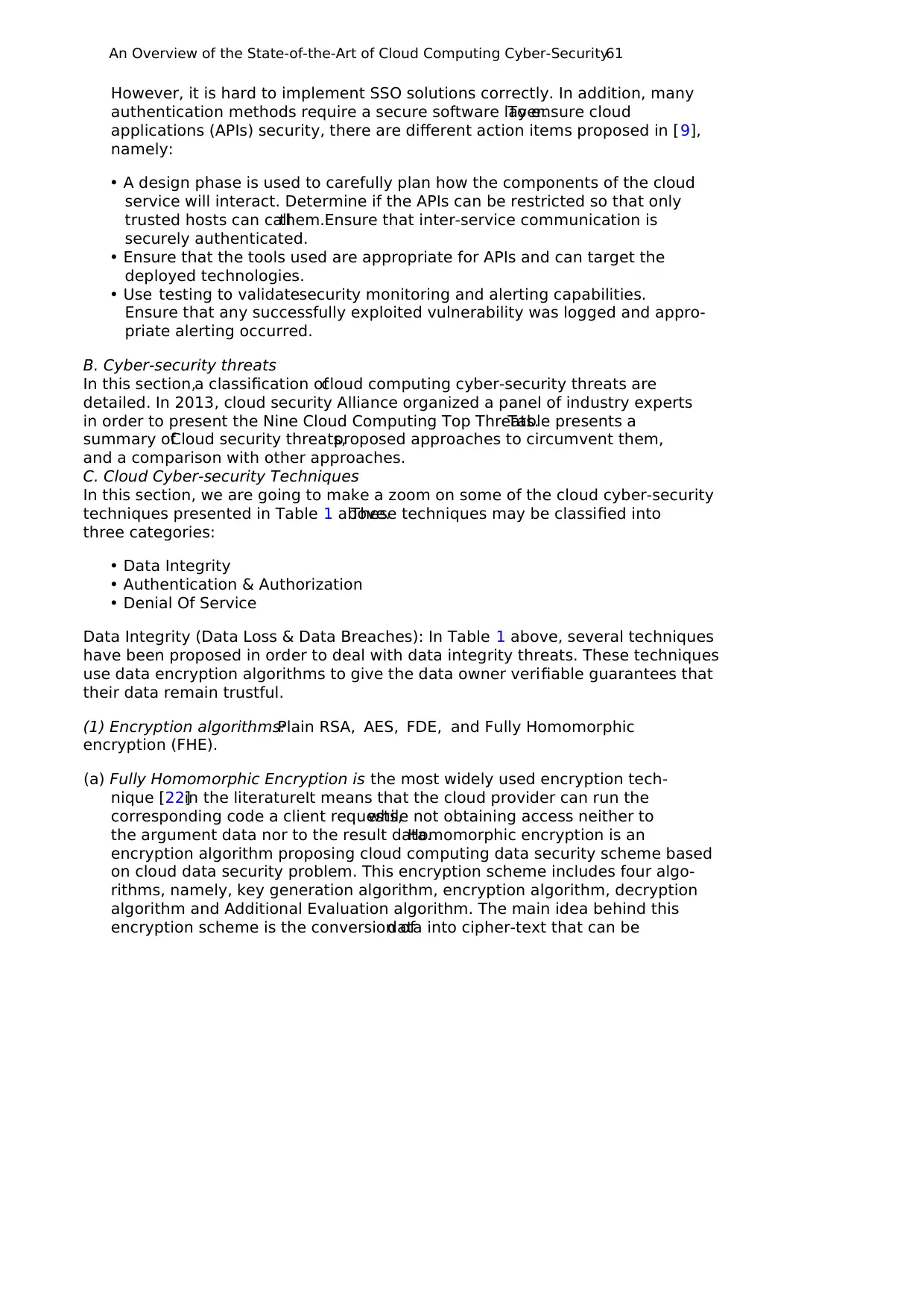
An Overview of the State-of-the-Art of Cloud Computing Cyber-Security61
However, it is hard to implement SSO solutions correctly. In addition, many
authentication methods require a secure software layer.To ensure cloud
applications (APIs) security, there are different action items proposed in [9],
namely:
• A design phase is used to carefully plan how the components of the cloud
service will interact. Determine if the APIs can be restricted so that only
trusted hosts can callthem.Ensure that inter-service communication is
securely authenticated.
• Ensure that the tools used are appropriate for APIs and can target the
deployed technologies.
• Use testing to validatesecurity monitoring and alerting capabilities.
Ensure that any successfully exploited vulnerability was logged and appro-
priate alerting occurred.
B. Cyber-security threats
In this section,a classification ofcloud computing cyber-security threats are
detailed. In 2013, cloud security Alliance organized a panel of industry experts
in order to present the Nine Cloud Computing Top Threats.Table presents a
summary ofCloud security threats,proposed approaches to circumvent them,
and a comparison with other approaches.
C. Cloud Cyber-security Techniques
In this section, we are going to make a zoom on some of the cloud cyber-security
techniques presented in Table 1 above.These techniques may be classified into
three categories:
• Data Integrity
• Authentication & Authorization
• Denial Of Service
Data Integrity (Data Loss & Data Breaches): In Table 1 above, several techniques
have been proposed in order to deal with data integrity threats. These techniques
use data encryption algorithms to give the data owner verifiable guarantees that
their data remain trustful.
(1) Encryption algorithms:Plain RSA, AES, FDE, and Fully Homomorphic
encryption (FHE).
(a) Fully Homomorphic Encryption is the most widely used encryption tech-
nique [22]in the literature.It means that the cloud provider can run the
corresponding code a client requests,while not obtaining access neither to
the argument data nor to the result data.Homomorphic encryption is an
encryption algorithm proposing cloud computing data security scheme based
on cloud data security problem. This encryption scheme includes four algo-
rithms, namely, key generation algorithm, encryption algorithm, decryption
algorithm and Additional Evaluation algorithm. The main idea behind this
encryption scheme is the conversion ofdata into cipher-text that can be
However, it is hard to implement SSO solutions correctly. In addition, many
authentication methods require a secure software layer.To ensure cloud
applications (APIs) security, there are different action items proposed in [9],
namely:
• A design phase is used to carefully plan how the components of the cloud
service will interact. Determine if the APIs can be restricted so that only
trusted hosts can callthem.Ensure that inter-service communication is
securely authenticated.
• Ensure that the tools used are appropriate for APIs and can target the
deployed technologies.
• Use testing to validatesecurity monitoring and alerting capabilities.
Ensure that any successfully exploited vulnerability was logged and appro-
priate alerting occurred.
B. Cyber-security threats
In this section,a classification ofcloud computing cyber-security threats are
detailed. In 2013, cloud security Alliance organized a panel of industry experts
in order to present the Nine Cloud Computing Top Threats.Table presents a
summary ofCloud security threats,proposed approaches to circumvent them,
and a comparison with other approaches.
C. Cloud Cyber-security Techniques
In this section, we are going to make a zoom on some of the cloud cyber-security
techniques presented in Table 1 above.These techniques may be classified into
three categories:
• Data Integrity
• Authentication & Authorization
• Denial Of Service
Data Integrity (Data Loss & Data Breaches): In Table 1 above, several techniques
have been proposed in order to deal with data integrity threats. These techniques
use data encryption algorithms to give the data owner verifiable guarantees that
their data remain trustful.
(1) Encryption algorithms:Plain RSA, AES, FDE, and Fully Homomorphic
encryption (FHE).
(a) Fully Homomorphic Encryption is the most widely used encryption tech-
nique [22]in the literature.It means that the cloud provider can run the
corresponding code a client requests,while not obtaining access neither to
the argument data nor to the result data.Homomorphic encryption is an
encryption algorithm proposing cloud computing data security scheme based
on cloud data security problem. This encryption scheme includes four algo-
rithms, namely, key generation algorithm, encryption algorithm, decryption
algorithm and Additional Evaluation algorithm. The main idea behind this
encryption scheme is the conversion ofdata into cipher-text that can be
Paraphrase This Document
Need a fresh take? Get an instant paraphrase of this document with our AI Paraphraser
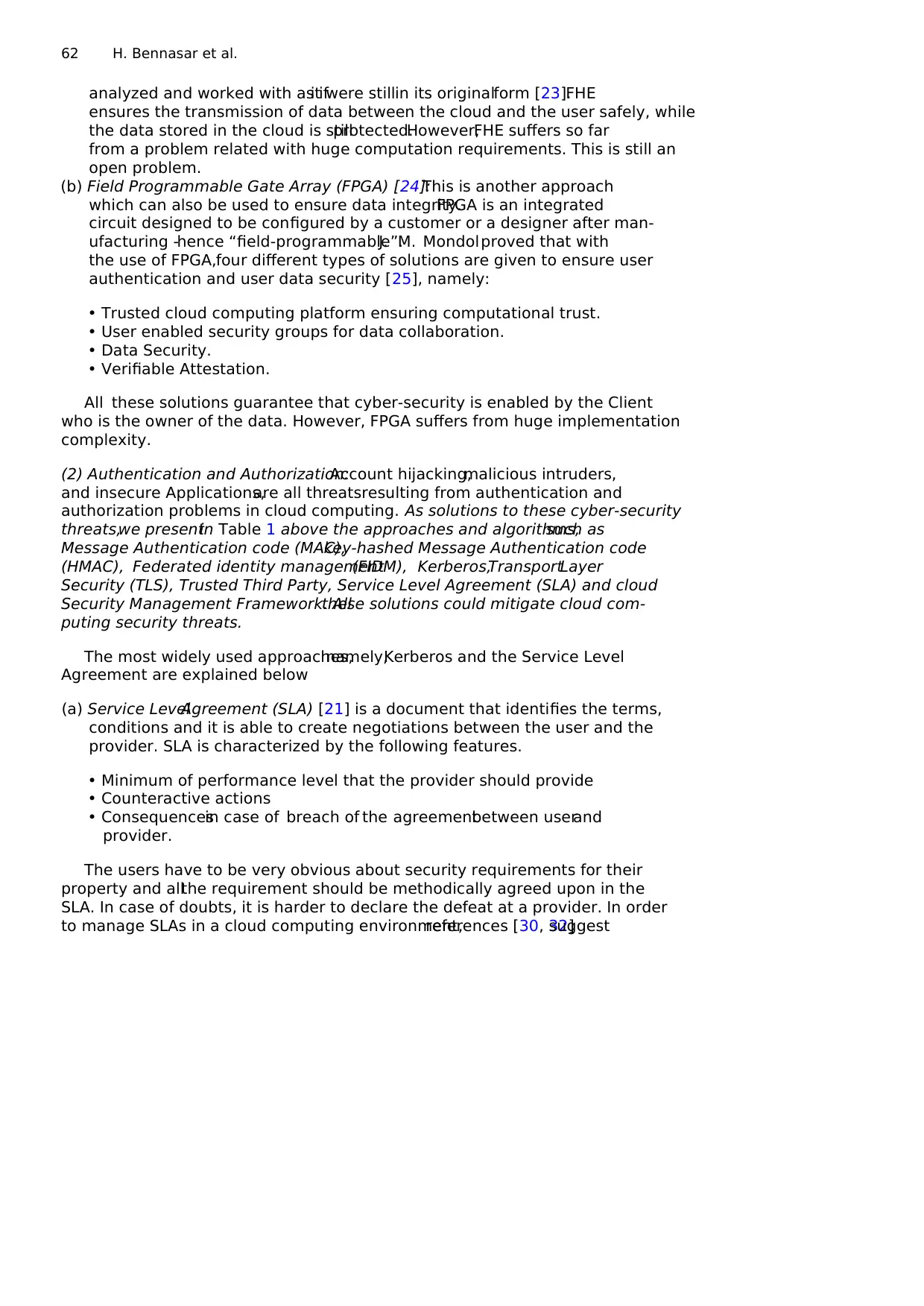
62 H. Bennasar et al.
analyzed and worked with as ifit were stillin its originalform [23].FHE
ensures the transmission of data between the cloud and the user safely, while
the data stored in the cloud is stillprotected.However,FHE suffers so far
from a problem related with huge computation requirements. This is still an
open problem.
(b) Field Programmable Gate Array (FPGA) [24]:This is another approach
which can also be used to ensure data integrity.FPGA is an integrated
circuit designed to be configured by a customer or a designer after man-
ufacturing -hence “field-programmable”.J. M. Mondol proved that with
the use of FPGA,four different types of solutions are given to ensure user
authentication and user data security [25], namely:
• Trusted cloud computing platform ensuring computational trust.
• User enabled security groups for data collaboration.
• Data Security.
• Verifiable Attestation.
All these solutions guarantee that cyber-security is enabled by the Client
who is the owner of the data. However, FPGA suffers from huge implementation
complexity.
(2) Authentication and Authorization:Account hijacking,malicious intruders,
and insecure Applications,are all threatsresulting from authentication and
authorization problems in cloud computing. As solutions to these cyber-security
threats,we presentin Table 1 above the approaches and algorithms,such as
Message Authentication code (MAC),key-hashed Message Authentication code
(HMAC), Federated identity management(FIDM), Kerberos,TransportLayer
Security (TLS), Trusted Third Party, Service Level Agreement (SLA) and cloud
Security Management Framework. Allthese solutions could mitigate cloud com-
puting security threats.
The most widely used approaches,namely,Kerberos and the Service Level
Agreement are explained below
(a) Service LevelAgreement (SLA) [21] is a document that identifies the terms,
conditions and it is able to create negotiations between the user and the
provider. SLA is characterized by the following features.
• Minimum of performance level that the provider should provide
• Counteractive actions
• Consequencesin case of breach of the agreementbetween userand
provider.
The users have to be very obvious about security requirements for their
property and allthe requirement should be methodically agreed upon in the
SLA. In case of doubts, it is harder to declare the defeat at a provider. In order
to manage SLAs in a cloud computing environment,references [30, 32]suggest
analyzed and worked with as ifit were stillin its originalform [23].FHE
ensures the transmission of data between the cloud and the user safely, while
the data stored in the cloud is stillprotected.However,FHE suffers so far
from a problem related with huge computation requirements. This is still an
open problem.
(b) Field Programmable Gate Array (FPGA) [24]:This is another approach
which can also be used to ensure data integrity.FPGA is an integrated
circuit designed to be configured by a customer or a designer after man-
ufacturing -hence “field-programmable”.J. M. Mondol proved that with
the use of FPGA,four different types of solutions are given to ensure user
authentication and user data security [25], namely:
• Trusted cloud computing platform ensuring computational trust.
• User enabled security groups for data collaboration.
• Data Security.
• Verifiable Attestation.
All these solutions guarantee that cyber-security is enabled by the Client
who is the owner of the data. However, FPGA suffers from huge implementation
complexity.
(2) Authentication and Authorization:Account hijacking,malicious intruders,
and insecure Applications,are all threatsresulting from authentication and
authorization problems in cloud computing. As solutions to these cyber-security
threats,we presentin Table 1 above the approaches and algorithms,such as
Message Authentication code (MAC),key-hashed Message Authentication code
(HMAC), Federated identity management(FIDM), Kerberos,TransportLayer
Security (TLS), Trusted Third Party, Service Level Agreement (SLA) and cloud
Security Management Framework. Allthese solutions could mitigate cloud com-
puting security threats.
The most widely used approaches,namely,Kerberos and the Service Level
Agreement are explained below
(a) Service LevelAgreement (SLA) [21] is a document that identifies the terms,
conditions and it is able to create negotiations between the user and the
provider. SLA is characterized by the following features.
• Minimum of performance level that the provider should provide
• Counteractive actions
• Consequencesin case of breach of the agreementbetween userand
provider.
The users have to be very obvious about security requirements for their
property and allthe requirement should be methodically agreed upon in the
SLA. In case of doubts, it is harder to declare the defeat at a provider. In order
to manage SLAs in a cloud computing environment,references [30, 32]suggest
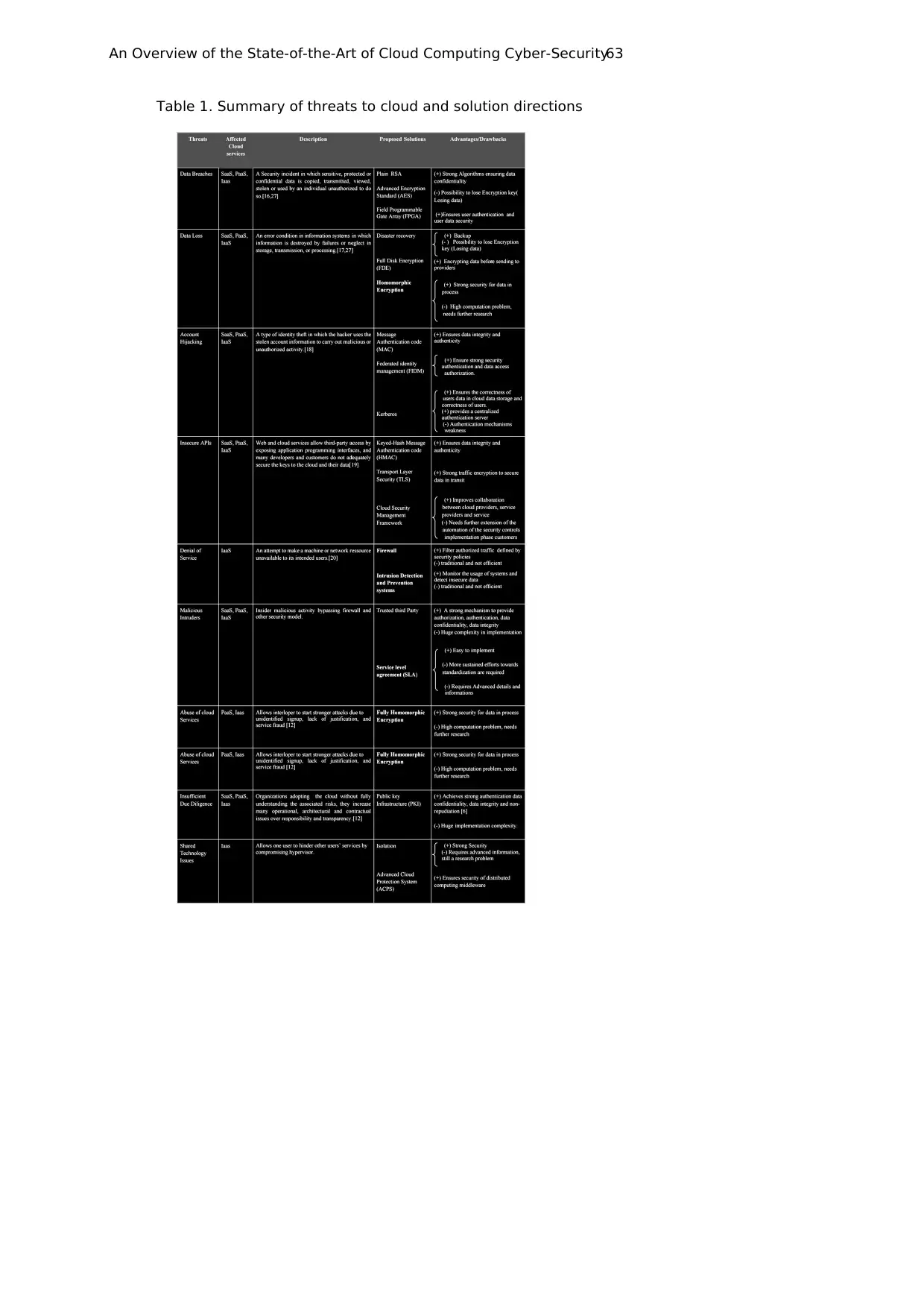
An Overview of the State-of-the-Art of Cloud Computing Cyber-Security63
Table 1. Summary of threats to cloud and solution directions
Table 1. Summary of threats to cloud and solution directions
⊘ This is a preview!⊘
Do you want full access?
Subscribe today to unlock all pages.

Trusted by 1+ million students worldwide
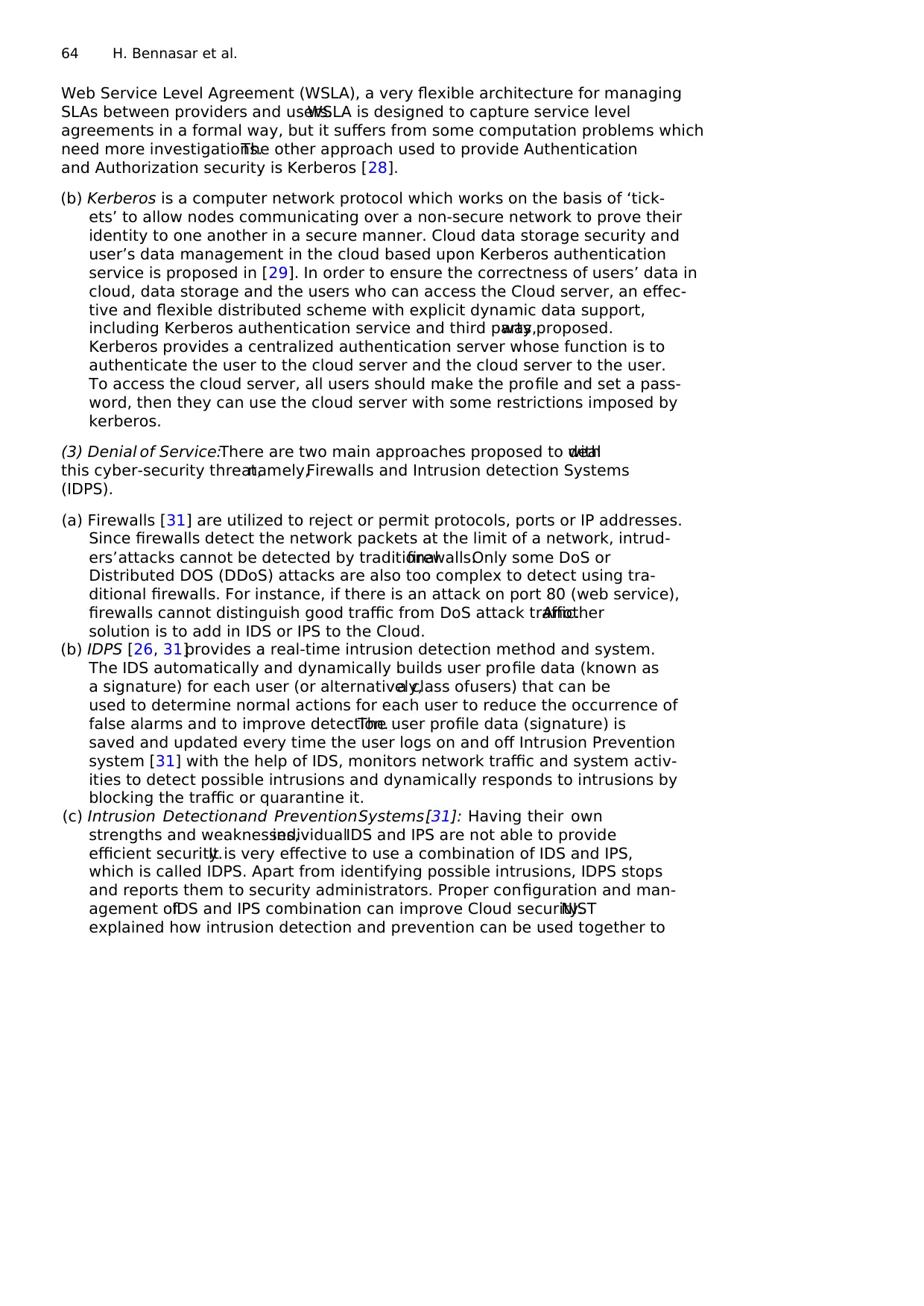
64 H. Bennasar et al.
Web Service Level Agreement (WSLA), a very flexible architecture for managing
SLAs between providers and users.WSLA is designed to capture service level
agreements in a formal way, but it suffers from some computation problems which
need more investigations.The other approach used to provide Authentication
and Authorization security is Kerberos [28].
(b) Kerberos is a computer network protocol which works on the basis of ‘tick-
ets’ to allow nodes communicating over a non-secure network to prove their
identity to one another in a secure manner. Cloud data storage security and
user’s data management in the cloud based upon Kerberos authentication
service is proposed in [29]. In order to ensure the correctness of users’ data in
cloud, data storage and the users who can access the Cloud server, an effec-
tive and flexible distributed scheme with explicit dynamic data support,
including Kerberos authentication service and third party,was proposed.
Kerberos provides a centralized authentication server whose function is to
authenticate the user to the cloud server and the cloud server to the user.
To access the cloud server, all users should make the profile and set a pass-
word, then they can use the cloud server with some restrictions imposed by
kerberos.
(3) Denial of Service:There are two main approaches proposed to dealwith
this cyber-security threat,namely,Firewalls and Intrusion detection Systems
(IDPS).
(a) Firewalls [31] are utilized to reject or permit protocols, ports or IP addresses.
Since firewalls detect the network packets at the limit of a network, intrud-
ers’attacks cannot be detected by traditionalfirewalls.Only some DoS or
Distributed DOS (DDoS) attacks are also too complex to detect using tra-
ditional firewalls. For instance, if there is an attack on port 80 (web service),
firewalls cannot distinguish good traffic from DoS attack traffic.Another
solution is to add in IDS or IPS to the Cloud.
(b) IDPS [26, 31]provides a real-time intrusion detection method and system.
The IDS automatically and dynamically builds user profile data (known as
a signature) for each user (or alternatively,a class ofusers) that can be
used to determine normal actions for each user to reduce the occurrence of
false alarms and to improve detection.The user profile data (signature) is
saved and updated every time the user logs on and off Intrusion Prevention
system [31] with the help of IDS, monitors network traffic and system activ-
ities to detect possible intrusions and dynamically responds to intrusions by
blocking the traffic or quarantine it.
(c) Intrusion Detectionand PreventionSystems[31]: Having their own
strengths and weaknesses,individualIDS and IPS are not able to provide
efficient security.It is very effective to use a combination of IDS and IPS,
which is called IDPS. Apart from identifying possible intrusions, IDPS stops
and reports them to security administrators. Proper configuration and man-
agement ofIDS and IPS combination can improve Cloud security.NIST
explained how intrusion detection and prevention can be used together to
Web Service Level Agreement (WSLA), a very flexible architecture for managing
SLAs between providers and users.WSLA is designed to capture service level
agreements in a formal way, but it suffers from some computation problems which
need more investigations.The other approach used to provide Authentication
and Authorization security is Kerberos [28].
(b) Kerberos is a computer network protocol which works on the basis of ‘tick-
ets’ to allow nodes communicating over a non-secure network to prove their
identity to one another in a secure manner. Cloud data storage security and
user’s data management in the cloud based upon Kerberos authentication
service is proposed in [29]. In order to ensure the correctness of users’ data in
cloud, data storage and the users who can access the Cloud server, an effec-
tive and flexible distributed scheme with explicit dynamic data support,
including Kerberos authentication service and third party,was proposed.
Kerberos provides a centralized authentication server whose function is to
authenticate the user to the cloud server and the cloud server to the user.
To access the cloud server, all users should make the profile and set a pass-
word, then they can use the cloud server with some restrictions imposed by
kerberos.
(3) Denial of Service:There are two main approaches proposed to dealwith
this cyber-security threat,namely,Firewalls and Intrusion detection Systems
(IDPS).
(a) Firewalls [31] are utilized to reject or permit protocols, ports or IP addresses.
Since firewalls detect the network packets at the limit of a network, intrud-
ers’attacks cannot be detected by traditionalfirewalls.Only some DoS or
Distributed DOS (DDoS) attacks are also too complex to detect using tra-
ditional firewalls. For instance, if there is an attack on port 80 (web service),
firewalls cannot distinguish good traffic from DoS attack traffic.Another
solution is to add in IDS or IPS to the Cloud.
(b) IDPS [26, 31]provides a real-time intrusion detection method and system.
The IDS automatically and dynamically builds user profile data (known as
a signature) for each user (or alternatively,a class ofusers) that can be
used to determine normal actions for each user to reduce the occurrence of
false alarms and to improve detection.The user profile data (signature) is
saved and updated every time the user logs on and off Intrusion Prevention
system [31] with the help of IDS, monitors network traffic and system activ-
ities to detect possible intrusions and dynamically responds to intrusions by
blocking the traffic or quarantine it.
(c) Intrusion Detectionand PreventionSystems[31]: Having their own
strengths and weaknesses,individualIDS and IPS are not able to provide
efficient security.It is very effective to use a combination of IDS and IPS,
which is called IDPS. Apart from identifying possible intrusions, IDPS stops
and reports them to security administrators. Proper configuration and man-
agement ofIDS and IPS combination can improve Cloud security.NIST
explained how intrusion detection and prevention can be used together to
Paraphrase This Document
Need a fresh take? Get an instant paraphrase of this document with our AI Paraphraser
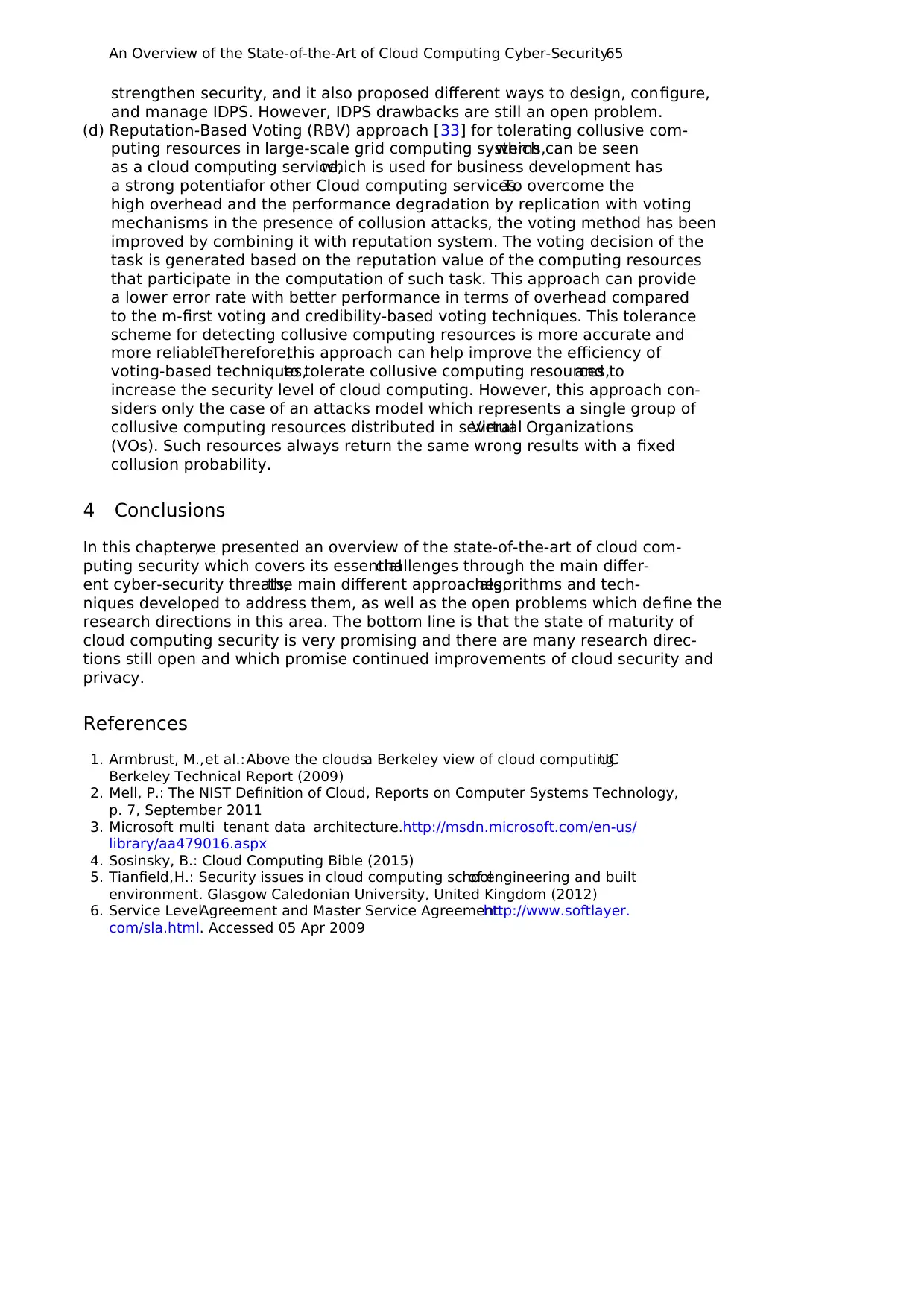
An Overview of the State-of-the-Art of Cloud Computing Cyber-Security65
strengthen security, and it also proposed different ways to design, configure,
and manage IDPS. However, IDPS drawbacks are still an open problem.
(d) Reputation-Based Voting (RBV) approach [33] for tolerating collusive com-
puting resources in large-scale grid computing systems,which can be seen
as a cloud computing service,which is used for business development has
a strong potentialfor other Cloud computing services.To overcome the
high overhead and the performance degradation by replication with voting
mechanisms in the presence of collusion attacks, the voting method has been
improved by combining it with reputation system. The voting decision of the
task is generated based on the reputation value of the computing resources
that participate in the computation of such task. This approach can provide
a lower error rate with better performance in terms of overhead compared
to the m-first voting and credibility-based voting techniques. This tolerance
scheme for detecting collusive computing resources is more accurate and
more reliable.Therefore,this approach can help improve the efficiency of
voting-based techniques,to tolerate collusive computing resources,and to
increase the security level of cloud computing. However, this approach con-
siders only the case of an attacks model which represents a single group of
collusive computing resources distributed in severalVirtual Organizations
(VOs). Such resources always return the same wrong results with a fixed
collusion probability.
4 Conclusions
In this chapter,we presented an overview of the state-of-the-art of cloud com-
puting security which covers its essentialchallenges through the main differ-
ent cyber-security threats,the main different approaches,algorithms and tech-
niques developed to address them, as well as the open problems which define the
research directions in this area. The bottom line is that the state of maturity of
cloud computing security is very promising and there are many research direc-
tions still open and which promise continued improvements of cloud security and
privacy.
References
1. Armbrust, M.,et al.:Above the clouds:a Berkeley view of cloud computing.UC
Berkeley Technical Report (2009)
2. Mell, P.: The NIST Definition of Cloud, Reports on Computer Systems Technology,
p. 7, September 2011
3. Microsoft multi tenant data architecture.http://msdn.microsoft.com/en-us/
library/aa479016.aspx
4. Sosinsky, B.: Cloud Computing Bible (2015)
5. Tianfield,H.: Security issues in cloud computing schoolof engineering and built
environment. Glasgow Caledonian University, United Kingdom (2012)
6. Service LevelAgreement and Master Service Agreement.http://www.softlayer.
com/sla.html. Accessed 05 Apr 2009
strengthen security, and it also proposed different ways to design, configure,
and manage IDPS. However, IDPS drawbacks are still an open problem.
(d) Reputation-Based Voting (RBV) approach [33] for tolerating collusive com-
puting resources in large-scale grid computing systems,which can be seen
as a cloud computing service,which is used for business development has
a strong potentialfor other Cloud computing services.To overcome the
high overhead and the performance degradation by replication with voting
mechanisms in the presence of collusion attacks, the voting method has been
improved by combining it with reputation system. The voting decision of the
task is generated based on the reputation value of the computing resources
that participate in the computation of such task. This approach can provide
a lower error rate with better performance in terms of overhead compared
to the m-first voting and credibility-based voting techniques. This tolerance
scheme for detecting collusive computing resources is more accurate and
more reliable.Therefore,this approach can help improve the efficiency of
voting-based techniques,to tolerate collusive computing resources,and to
increase the security level of cloud computing. However, this approach con-
siders only the case of an attacks model which represents a single group of
collusive computing resources distributed in severalVirtual Organizations
(VOs). Such resources always return the same wrong results with a fixed
collusion probability.
4 Conclusions
In this chapter,we presented an overview of the state-of-the-art of cloud com-
puting security which covers its essentialchallenges through the main differ-
ent cyber-security threats,the main different approaches,algorithms and tech-
niques developed to address them, as well as the open problems which define the
research directions in this area. The bottom line is that the state of maturity of
cloud computing security is very promising and there are many research direc-
tions still open and which promise continued improvements of cloud security and
privacy.
References
1. Armbrust, M.,et al.:Above the clouds:a Berkeley view of cloud computing.UC
Berkeley Technical Report (2009)
2. Mell, P.: The NIST Definition of Cloud, Reports on Computer Systems Technology,
p. 7, September 2011
3. Microsoft multi tenant data architecture.http://msdn.microsoft.com/en-us/
library/aa479016.aspx
4. Sosinsky, B.: Cloud Computing Bible (2015)
5. Tianfield,H.: Security issues in cloud computing schoolof engineering and built
environment. Glasgow Caledonian University, United Kingdom (2012)
6. Service LevelAgreement and Master Service Agreement.http://www.softlayer.
com/sla.html. Accessed 05 Apr 2009
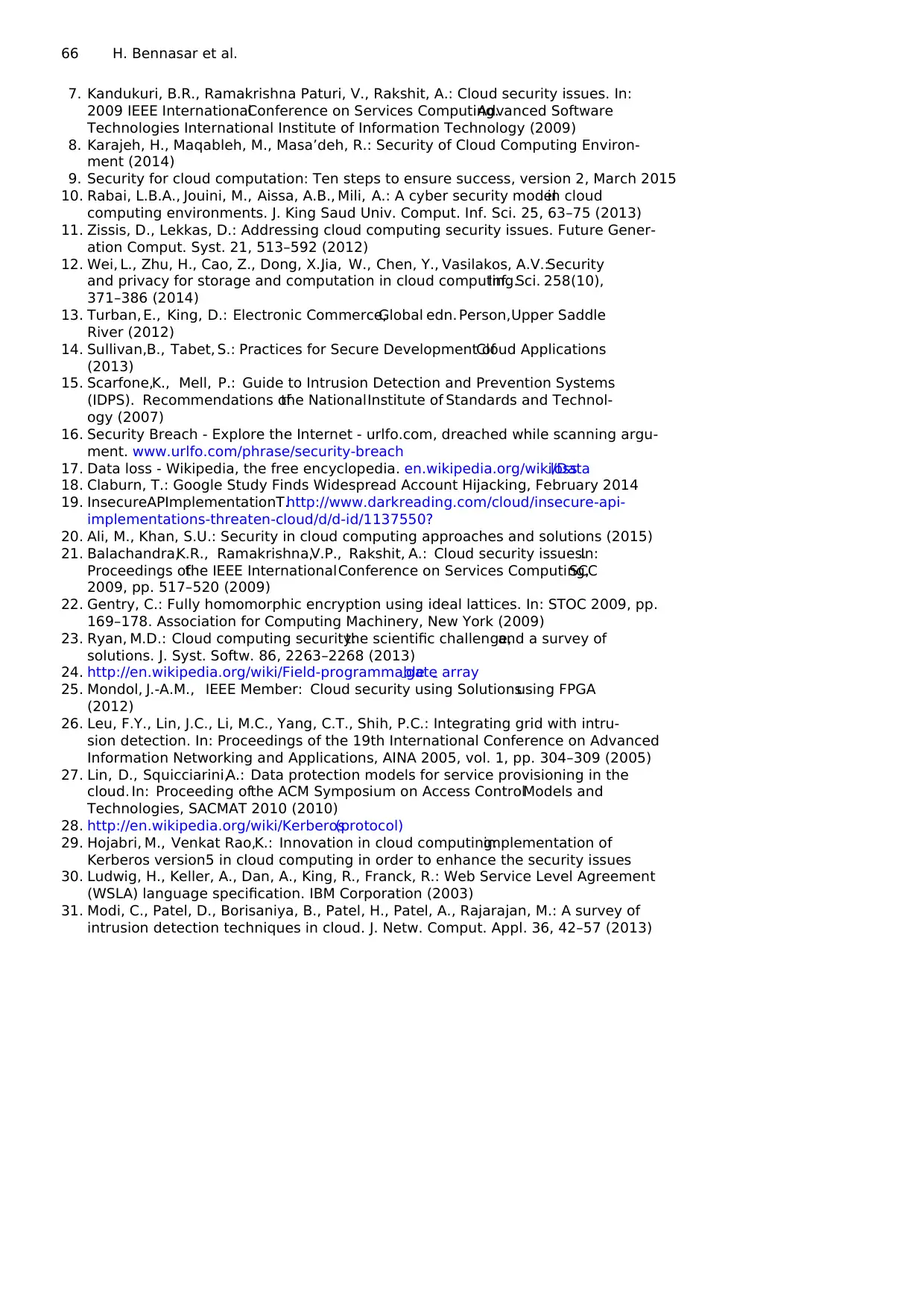
66 H. Bennasar et al.
7. Kandukuri, B.R., Ramakrishna Paturi, V., Rakshit, A.: Cloud security issues. In:
2009 IEEE InternationalConference on Services Computing.Advanced Software
Technologies International Institute of Information Technology (2009)
8. Karajeh, H., Maqableh, M., Masa’deh, R.: Security of Cloud Computing Environ-
ment (2014)
9. Security for cloud computation: Ten steps to ensure success, version 2, March 2015
10. Rabai, L.B.A., Jouini, M., Aissa, A.B., Mili, A.: A cyber security modelin cloud
computing environments. J. King Saud Univ. Comput. Inf. Sci. 25, 63–75 (2013)
11. Zissis, D., Lekkas, D.: Addressing cloud computing security issues. Future Gener-
ation Comput. Syst. 21, 513–592 (2012)
12. Wei, L., Zhu, H., Cao, Z., Dong, X.,Jia, W., Chen, Y., Vasilakos, A.V.:Security
and privacy for storage and computation in cloud computing.Inf. Sci. 258(10),
371–386 (2014)
13. Turban, E., King, D.: Electronic Commerce,Global edn. Person,Upper Saddle
River (2012)
14. Sullivan,B., Tabet, S.: Practices for Secure Development ofCloud Applications
(2013)
15. Scarfone,K., Mell, P.: Guide to Intrusion Detection and Prevention Systems
(IDPS). Recommendations ofthe NationalInstitute of Standards and Technol-
ogy (2007)
16. Security Breach - Explore the Internet - urlfo.com, dreached while scanning argu-
ment. www.urlfo.com/phrase/security-breach
17. Data loss - Wikipedia, the free encyclopedia. en.wikipedia.org/wiki/Dataloss
18. Claburn, T.: Google Study Finds Widespread Account Hijacking, February 2014
19. InsecureAPImplementationT.http://www.darkreading.com/cloud/insecure-api-
implementations-threaten-cloud/d/d-id/1137550?
20. Ali, M., Khan, S.U.: Security in cloud computing approaches and solutions (2015)
21. Balachandra,K.R., Ramakrishna,V.P., Rakshit, A.: Cloud security issues.In:
Proceedings ofthe IEEE InternationalConference on Services Computing,SCC
2009, pp. 517–520 (2009)
22. Gentry, C.: Fully homomorphic encryption using ideal lattices. In: STOC 2009, pp.
169–178. Association for Computing Machinery, New York (2009)
23. Ryan, M.D.: Cloud computing security:the scientific challenge,and a survey of
solutions. J. Syst. Softw. 86, 2263–2268 (2013)
24. http://en.wikipedia.org/wiki/Field-programmablegate array
25. Mondol, J.-A.M., IEEE Member: Cloud security using Solutionsusing FPGA
(2012)
26. Leu, F.Y., Lin, J.C., Li, M.C., Yang, C.T., Shih, P.C.: Integrating grid with intru-
sion detection. In: Proceedings of the 19th International Conference on Advanced
Information Networking and Applications, AINA 2005, vol. 1, pp. 304–309 (2005)
27. Lin, D., Squicciarini,A.: Data protection models for service provisioning in the
cloud. In: Proceeding ofthe ACM Symposium on Access ControlModels and
Technologies, SACMAT 2010 (2010)
28. http://en.wikipedia.org/wiki/Kerberos(protocol)
29. Hojabri, M., Venkat Rao,K.: Innovation in cloud computing:implementation of
Kerberos version5 in cloud computing in order to enhance the security issues
30. Ludwig, H., Keller, A., Dan, A., King, R., Franck, R.: Web Service Level Agreement
(WSLA) language specification. IBM Corporation (2003)
31. Modi, C., Patel, D., Borisaniya, B., Patel, H., Patel, A., Rajarajan, M.: A survey of
intrusion detection techniques in cloud. J. Netw. Comput. Appl. 36, 42–57 (2013)
7. Kandukuri, B.R., Ramakrishna Paturi, V., Rakshit, A.: Cloud security issues. In:
2009 IEEE InternationalConference on Services Computing.Advanced Software
Technologies International Institute of Information Technology (2009)
8. Karajeh, H., Maqableh, M., Masa’deh, R.: Security of Cloud Computing Environ-
ment (2014)
9. Security for cloud computation: Ten steps to ensure success, version 2, March 2015
10. Rabai, L.B.A., Jouini, M., Aissa, A.B., Mili, A.: A cyber security modelin cloud
computing environments. J. King Saud Univ. Comput. Inf. Sci. 25, 63–75 (2013)
11. Zissis, D., Lekkas, D.: Addressing cloud computing security issues. Future Gener-
ation Comput. Syst. 21, 513–592 (2012)
12. Wei, L., Zhu, H., Cao, Z., Dong, X.,Jia, W., Chen, Y., Vasilakos, A.V.:Security
and privacy for storage and computation in cloud computing.Inf. Sci. 258(10),
371–386 (2014)
13. Turban, E., King, D.: Electronic Commerce,Global edn. Person,Upper Saddle
River (2012)
14. Sullivan,B., Tabet, S.: Practices for Secure Development ofCloud Applications
(2013)
15. Scarfone,K., Mell, P.: Guide to Intrusion Detection and Prevention Systems
(IDPS). Recommendations ofthe NationalInstitute of Standards and Technol-
ogy (2007)
16. Security Breach - Explore the Internet - urlfo.com, dreached while scanning argu-
ment. www.urlfo.com/phrase/security-breach
17. Data loss - Wikipedia, the free encyclopedia. en.wikipedia.org/wiki/Dataloss
18. Claburn, T.: Google Study Finds Widespread Account Hijacking, February 2014
19. InsecureAPImplementationT.http://www.darkreading.com/cloud/insecure-api-
implementations-threaten-cloud/d/d-id/1137550?
20. Ali, M., Khan, S.U.: Security in cloud computing approaches and solutions (2015)
21. Balachandra,K.R., Ramakrishna,V.P., Rakshit, A.: Cloud security issues.In:
Proceedings ofthe IEEE InternationalConference on Services Computing,SCC
2009, pp. 517–520 (2009)
22. Gentry, C.: Fully homomorphic encryption using ideal lattices. In: STOC 2009, pp.
169–178. Association for Computing Machinery, New York (2009)
23. Ryan, M.D.: Cloud computing security:the scientific challenge,and a survey of
solutions. J. Syst. Softw. 86, 2263–2268 (2013)
24. http://en.wikipedia.org/wiki/Field-programmablegate array
25. Mondol, J.-A.M., IEEE Member: Cloud security using Solutionsusing FPGA
(2012)
26. Leu, F.Y., Lin, J.C., Li, M.C., Yang, C.T., Shih, P.C.: Integrating grid with intru-
sion detection. In: Proceedings of the 19th International Conference on Advanced
Information Networking and Applications, AINA 2005, vol. 1, pp. 304–309 (2005)
27. Lin, D., Squicciarini,A.: Data protection models for service provisioning in the
cloud. In: Proceeding ofthe ACM Symposium on Access ControlModels and
Technologies, SACMAT 2010 (2010)
28. http://en.wikipedia.org/wiki/Kerberos(protocol)
29. Hojabri, M., Venkat Rao,K.: Innovation in cloud computing:implementation of
Kerberos version5 in cloud computing in order to enhance the security issues
30. Ludwig, H., Keller, A., Dan, A., King, R., Franck, R.: Web Service Level Agreement
(WSLA) language specification. IBM Corporation (2003)
31. Modi, C., Patel, D., Borisaniya, B., Patel, H., Patel, A., Rajarajan, M.: A survey of
intrusion detection techniques in cloud. J. Netw. Comput. Appl. 36, 42–57 (2013)
⊘ This is a preview!⊘
Do you want full access?
Subscribe today to unlock all pages.

Trusted by 1+ million students worldwide
1 out of 13
Your All-in-One AI-Powered Toolkit for Academic Success.
+13062052269
info@desklib.com
Available 24*7 on WhatsApp / Email
![[object Object]](/_next/static/media/star-bottom.7253800d.svg)
Unlock your academic potential
Copyright © 2020–2025 A2Z Services. All Rights Reserved. Developed and managed by ZUCOL.

